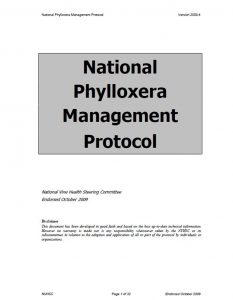In 2009, the viticulture industries (wine and table grapes) in conjunction with state regulators – through the National Vine Health Steering Committee – developed a National Phylloxera Management Protocol (NPMP), being an agreed standard for managing the movement of risk vectors so as to minimise the risk of spreading phylloxera. The NPMP also includes a procedure for the upgrading of phylloxera zone status.
The NPMP covers the movement of grapevines, vineyard machinery, grapes, people and grape products from Phylloxera Infested Zones and Phylloxera Risk Zones into non-infested zones (see map of phylloxera zones in Australia). It gives details on the recommended disinfestation treatments for machinery, footwear, vehicles etc that can be applied in any vineyard situation.
Given that significant phylloxera research has been undertaken since the publishing of the NPMP in 2009, identifying that some of the disinfestation procedures within this document are ineffective against Australia’s key endemic phylloxera strains, this protocol is out of date and requires urgent updating. Some examples of this science include:
- Footwear and small hand tool disinfestation is ineffective in a 2% sodium hypochlorite solution at 30 seconds with a water rinse thereafter. This has been replaced since January 2017 with a 2% sodium hypochlorite solution for 60 seconds without a water rinse thereafter. An alternative available from September 2021 is to use undiluted Dettol for 60 seconds without a water rinse thereafter.
- Machinery and equipment sterilisation is ineffective when conducted for a duration of 2 hours at 40 degrees Celsius. This has been replaced in South Australia’s Plant Quarantine Standard since May 2020 for a duration of 3 hours when undertaken at 40 degrees Celsius.
Vinehealth Australia continues to advocate nationally for an urgent review and update of the NPMP, including Rezoning Procedure, to ensure that industry and government’s actions towards minimising the risk of spread of phylloxera are based on latest scientific information on phylloxera biology, detection, surveillance and contemporary biosecurity principles.
